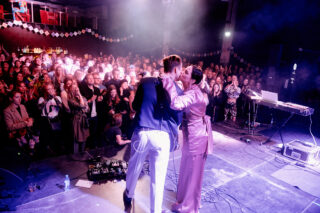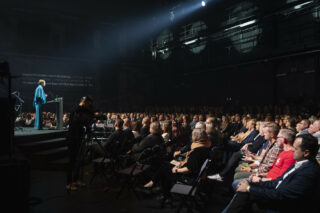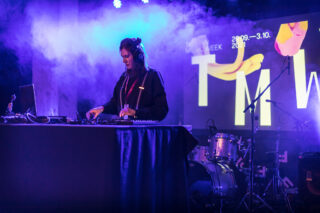Tallinn Music Week: a vision of a progressive European musical future
And a damning indictment of the state of play here in Britain

And a damning indictment of the state of play here in Britain
The opening night reception of Tallinn Music Week is a moving one in the Estonian capital – but it’s also coated with an inescapable melancholy for UK visitors.
Inside an old power plant, full of rusting pipes and sprawling metalwork that climbs the walls like Boston ivy, the President of Estonia speaks.
“Surely you’ve felt that feeling, when you’re walking home after hearing a piece of music or seeing a play that touches on an important topic in society,” she asks. “You somehow feel that you’re better, more idealistic, full of the desire to go help and get something done. I believe we’ve all felt it. And it counts. That is why it is so important that culture that echoes reaches many people in the whole of society. Because those who have lost their ability to see creation in their daily lives can easily lose the will to think about the creation of others.”

It’s affecting to witness a public political figure speak about culture with such sincerity, thoughtfulness and first-hand experience. But it’s also tinged with great sadness because there’s a very acute awareness of what an alien feeling this would be in England, a country where the Prime Minister’s thoughts on culture expand little further than how he can further protect rights for fox hunters.
Watching the President of a country speak about the integral and inherent power of culture and how it should be ingrained in children at primary school level only serves to hit home England’s obdurate desire to position itself as a country with no interest, or even base level understanding, of the collective and potent power of shared cultural experiences across societies, countries and continents.
TMW is not stacked with typical UK buzz bands that fill every festival across Europe – even though a great deal of those can’t even tour the continent at the moment anyway due to Brexit – nor is it packed with equally familiar Pitchfork-friendly American outfits. Instead there’s a heavy focus on local Estonian music, as well as artists from nearby countries like Finland, Russia, Latvia and Lithuania. Even serious music heads may take a look at the line-up and struggle to put together a weekend-long schedule based on artists they already know. Which is exactly what makes it such a refreshing experience to encounter.
The first artist seen is local outfit Centre El Muusa. They are already deep into a dream-pop meets space rock groove by the time I arrive and they stay in one for the next 30 minutes. Marrying the more tender instrumental moments of Yo La Tengo with nods to Mazzy Star and touches of the greatly overlooked LA outfit Acetone, they occasionally lift off into more typical explosive psych-tinged noise but they’re just as powerful in their subtle restraint. dreamkrusher! are much more interested in the pulverising end of the psychedelic rock spectrum, as their more melodic and structured songs rattle the innards of the crowd.
Monikaze, otherwise known as Monika Zenkeviciute, is an unquestionable highlight of the weekend. Fusing thumping industrial techno with dark ambient and gliding between just about every conceivable electronic genre in the process. Singing over the top of her beat-heavy compositions, she’s occasionally held back and soft and occasionally soaring, at times sounding like Björk if she’d gone full ear blaster techno.

Hatari, who represented Iceland in the Eurovision song contest in 2019, are hilarious. It’s difficult to tell if they are a carefully constructed outfit with humour rooted into their core essence or so deadly serious as to have missed it entirely. Aesthetically, they make up a dichotomous bunch: a gyrating, hip thrusting, blonde-haired singer who prowls in an Edward Scissorhands-esque costume and unleashes lung-busting metal screams, all driven home by a drummer who looks like an extra from Mad Max. It’s an assault of industrial-meets-pop-meets-techno and contains not the tiniest whiff of subtlety, but for a 10-minute burst it’s a riot. 40 minutes later their limits are tested and things feel a bit one-note.
The St Petersburg venue Kruzhok takes over an amazing space in the city, Kauplus Aasia, and its founder performs under his alias Batya as part of the eclectic evening. Dressed head to toe in a red tracksuit with black sunglasses on, he sits somewhere between Sleaford Mods and Har Mar Superstar, as grubby ’90s electro beats collide with a little bit of affected sleaze and grit, singing songs that vary in topic from sex to Russian economics. On the final day, Mart Avi’s Jarvis Cocker-like strut through a world of outsider pop has plenty of charm and idiosyncrasies but for the first and only time all weekend, the sound just isn’t there to amplify it effectively.
Bouncing around TMW, you realise that one of the greatest assets of the festival is Tallinn itself. A beautiful, varied city, it is loaded with incredible venues, from the aforementioned ex-power plant (that features in Andrei Tarkovsky’s 1979 masterpiece Stalker) to slick new clubs, dive bars, DIY spots, a photography gallery and their own version of Berghain (minus the insane hedonism) in Hall. The latter stands as a towering square of ominous concrete that bleeds an aura verging on brutal punishment; it’s the perfect space to spend the last hours of the festival listening to panel beaters from Prague techno.
Attending my first overseas festival since the UK left the EU, I’m initially left with a heightened sense of loss and detachment. Witnessing a festival with a complicated history of national identity actively celebrating cross-country unity via music is a wonderful thing, and it’s profoundly sad that we’ve chosen to remove ourselves from being able to participate in such things.

However, if there is any sense of hope or positivity to pluck from the UK’s reduced role and function in a wider European musical landscape, perhaps it’s to be found in a re-evaluation of how we see Anglo-American music, either as the norm or as some kind of template to follow for how festivals and live events work. 177 artists performed at TMW, and only three of them were from the UK and the US. Perhaps we should view ratios like that not as unusual or skewered but symbolic of how grossly misrepresented many of the artists from this part of the world are on the live circuit and in our media.
This raises certain questions: what do we want from cultural exchanges and interactions moving forward in a new, and recontextualized world? What do we want our music media to look like, how do we want venues to operate and what do we want from live performance?
Pressing ahead, it’s never been more important to choose carefully who and where we invest our time, efforts and money into because we’ve had a taste of what the world may look like without some of them – and it’s fucking bleak. Do we want to move forward in a world that throws money behind the bar of a national pub chain that actively campaigned for Brexit and threw its staff under the bus during the pandemic, or do we choose to go to the spaces and venues that selflessly positioned themselves as foodbank stations or vital pillars of their community during a time of need?
As music festivals open back up, we have much the same issues to consider: how can we, as lovers and supporters of music, contribute to the functionality and economy of the live music world? Do we want to go to cookie cutter events in which line-ups are simply identikit packs moved along an assembly line from one location to another with banal regularity by the same promoter? Or do we want to immerse ourselves in something thoughtfully curated that results not only in a unique encounter but something that helps bolster and foster that world into a better place?
Considering all the music festivals across Europe that claim to be unique, special or pioneering, TMW is actually distinct, filled with discovery and guaranteed to provide a deep plunge into a musical world that other festivals barely offer a peek into.
Lead photograph by Kaarel Antonov